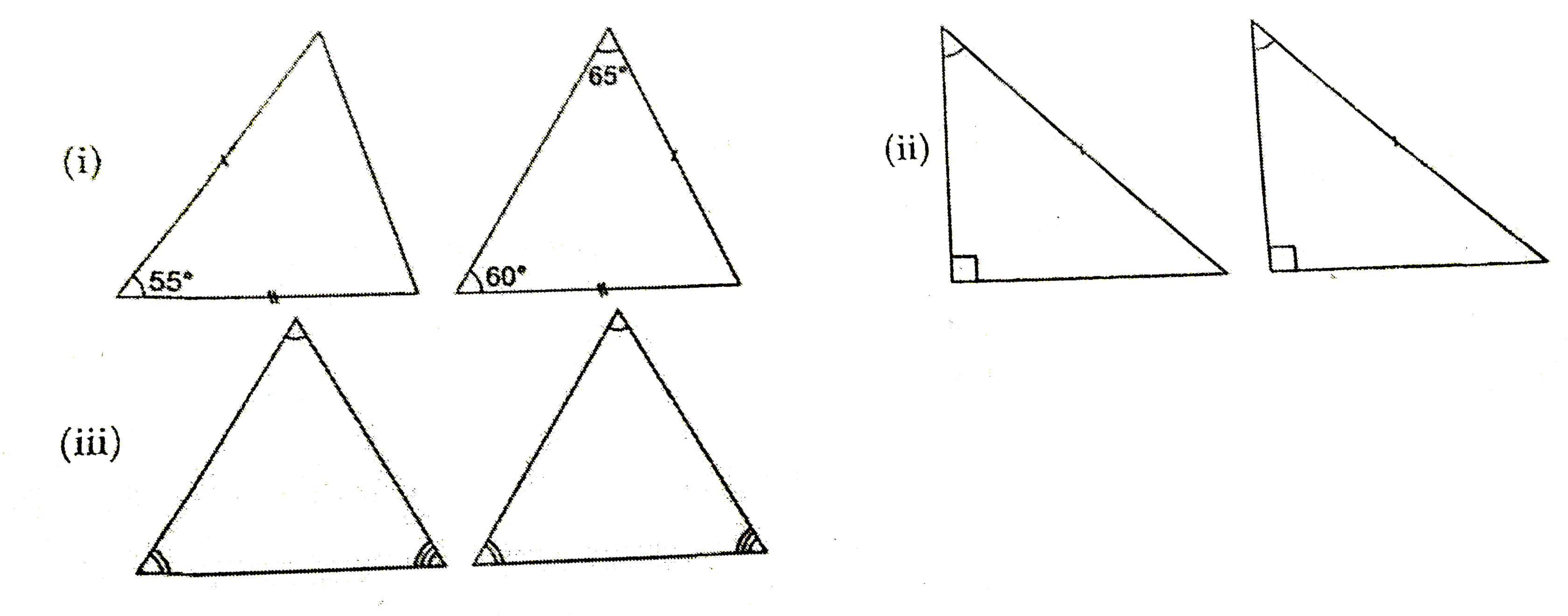
ΔABC≅ΔQRP. Match the following :
(P)AB=(1)∠Q(Q)BC=(2)QP(R)AC=(3)QR(S)∠A=(4)RP
P-1, Q-2, R-3, S-4
P-3, Q-2, R-4, S-1
P-3, Q-4, R-2, S-1
P-2, Q-3, R-4, S-1
The correct Answer is:C
Topper's Solved these Questions
- TRIANGLESBOOK - MTG IIT JEE FOUNDATIONCHAPTER - TRIANGLESEXERCISE - EXERCISE (Multiple Choice Questions) (ASSERTION & REASON TYPE)
5 Videos
- TRIANGLESBOOK - MTG IIT JEE FOUNDATIONCHAPTER - TRIANGLESEXERCISE - EXERCISE (Multiple Choice Questions) (COMPREHENSION TYPE)
3 Videos
- TRIANGLESBOOK - MTG IIT JEE FOUNDATIONCHAPTER - TRIANGLESEXERCISE - EXERCISE (Multiple Choice Questions) (LEVEL-2 )
10 Videos
- STATISTICSBOOK - MTG IIT JEE FOUNDATIONCHAPTER - STATISTICSEXERCISE - Olympiad/HOTS Corner
20 Videos
Similar Questions
Which of the following pairs of triangles are congruent ? Also state the condition of congruency in each case :

(iv) In ΔABC and ΔDEF,AB=EF,BC=DF and ∠B=∠F
(v) In ΔABC and ΔPQR,AB=QR,AC=PR and ∠B=∠R
(vi) In ΔABC and ΔPQR,∠A=∠P,AC=PR and AB=PQ
(vi) In ΔABC and ΔPQR,AB=QR,∠A=∠Q and AC=QP.
View SolutionWhich of the following pairs of triangles are congruent ? Also state the condition of congruency in each case :

(iv) In ΔABC and ΔDEF,AB=EF,BC=DF and ∠B=∠F
(v) In ΔABC and ΔPQR,AB=QR,AC=PR and ∠B=∠R
(vi) In ΔABC and ΔPQR,∠A=∠P,AC=PR and AB=PQ
(vi) In ΔABC and ΔPQR,AB=QR,∠A=∠Q and AC=QP.
View Solution
Knowledge Check
Let ΔABC~ΔPQRandar(ΔABC)ar(ΔPQR)=425. If AB=12cm,BC=8cmandAC=10cm then QR is equal to
Aa)15Bb)18Cc)25Dd)20In ΔABC,∠C=∠A,BC=4cmandAC=5cm. Then, AB = ?
A4 cmB5 cmC5 cmD2.5 cmIn ΔABC, if ∠A:∠B:∠C=1:2:3, then what is BC:CA:AB?
A1:2:3B1:√3:2C2:√3:1D√3:1:2
If ΔABC~ΔRPQ ,AB = 3 cm ,BC = 5 cm , AC = 6 cm , RP = 6 cm and PQ = 10 cm , then find QR.
View SolutionA(3,4),B(0,0)andc(3,0) are vertices of ΔABC. If 'P' is the point inside the ΔABC, such that d(P,BC)≤ min. {d(P,AB),d(P,AC)}. Then the maximum of d(P,BC) is.(where d(P,BC) represent distance between PandBC).
View SolutionA(3,4),B(0,0)andc(3,0) are vertices of ΔABC. If 'P' is the point inside the ΔABC, such that d(P,BC)≤ min. {d(P,AB),d(P,AC)}. Then the maximum of d(P,BC) is.(where d(P,BC) represent distance between PandBC).
View SolutionConstruct a ΔABC in which AB = 3 cm, ∠A=90∘ and BC - AC = 1 cm.
View SolutionIn ΔABC, bisector of ∠A intersects BC at D. If AB = 4 cm, AC = 3 cm and ∠A=60∘, then find the length of AD-
View Solution
